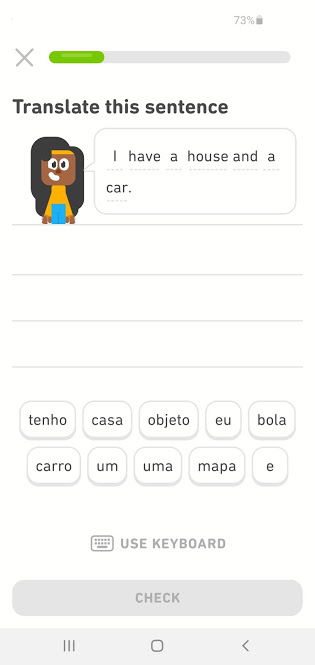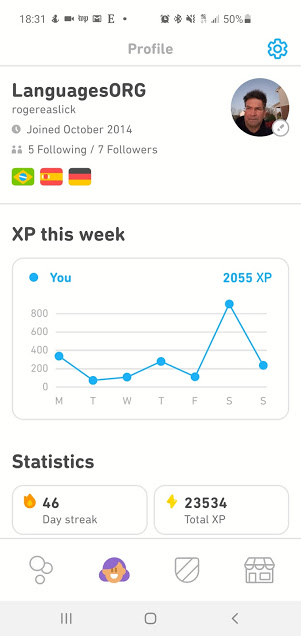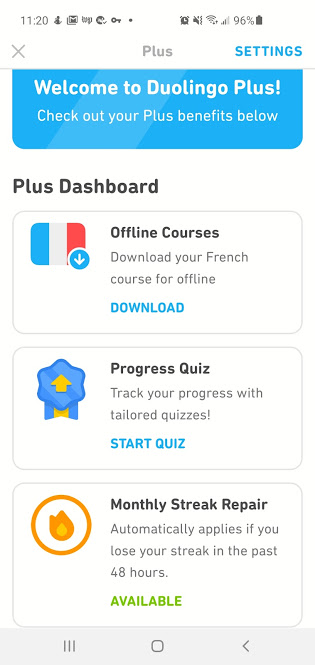Duolingo is a great free language learning program to help you get started and stay motivated while increasing your skill level in a foreign language. It combines the right amount of motivation through gamification with short interactive exercises that incrementally increase your understanding of the language.

But Duolingo does have its detractors. More on that later.
As of this writing Duolingo claims to have over 300 million users and to be the “most popular language-learning platform and the most downloaded education app in the world.”
Like any method of learning a language, Duolingo has its strengths and weaknesses. Personally I think it is a more than adequate method for starting out in a language.
For a free language program it could even be called amazing.
One of my favorite features is Duolingo stories, currently offered in German, French, Spanish and Portuguese. More about that later as well.
Currently, you can study over 20 languages within Duolingo. The more popular ones like Spanish, Mandarin Chinese, French, German and Italian are offered but you can also expose yourself to made up languages like Klingon and High Valyrian or endangered ones like Hawaiian or Navajo.
In order to review this program, I tried it in German, French, Spanish and Portuguese – which I’m pretty strong in — and Italian and Mandarin Chinese, in which I’m very much a beginner.
How does Duolingo work?

Duolingo is available as an app for Android and IOS devices as well as for browsers. You start with short exercises built around basic vocabulary.
Duolingo uses a number of methods to help you learn the language and absorb the grammar in each lesson.
One method is translating to or from the target language. In one variation you have the written phrase or sentence with a voice that reads it out loud. Another variation just gives you the written sentence.
For the romance languages, Duolingo presents you with a sentence or phrase to translate from English to the target language or vice versa. You are asked to translate by either using the keyboard or, more often, by piecing together word blocks.

(The choice between using word blocks or typing with the keyboard seems to have reached the Android app. It is offering me the choice on my phone but not on my daughters’ Android phones. The only difference is that I am currently a PLUS member for testing purposes…)
Sometimes you are prompted to type exactly what you hear. No translating. The voices, again in the romance languages (and German), are very clear, natural and easy to understand.
The speed seems to be normal, not rushed, but not overly slow. Mama bear speed in other words. You can hit a turtle icon and have the phrase spoken at a much slower speed which comes in handy occasionally since sometimes the words seem to run together. I blame this on my brain’s sound processor and not the speaker.
You can also skip the listening exercise if you are somewhere where the noise would bother others by selecting the “can’t listen now” option at the bottom of the exercise.
In an attempt at getting you to practice speaking, Duolingo will ask you from time to time to speak what you hear. It seems quite forgiving, but if your pronunciation deviates too much it will tell you that “That doesn’t sound right.” You then have the option of trying again or just moving on.
Motivation and Leagues
I find Duolingo to be quite addicting.
The short exercises help. But the leagues help even more.

Duolingo puts you in a random group of people called a league. Each week you have the opportunity of advancing to the next higher league by staying in the top ten within the league or at least by being within the top ten at the end of the week when the leagues change.
As you work through the exercises you receive points called XP. The more exercises you complete, the more XP you accumulate and the higher your ranking within the league.
Duolingo used to allow you to create your own language clubs but as you can imagine there were issues with that. When one or more people in your club go slack it takes the fun out of competing since there is no one to compete with so the incentive is gone.
With leagues, the groups vary in motivation. Some members study for hours and amass hundreds of points and shoot to the top. Others are more laid back and show less competitive spirit.
Whenever someone passes you, you receive an alert that lets you regain your dominance — if you want to. It does tend to spur people on.
Each week the scores are reset for the league and you are thrown into another random group of people so if you have gotten far behind in the last week, good news! You are on a new level playing field at the beginning of the new week and have a chance to shine.
Skills, Lessons, Levels and Crowns
Another incentive Duolingo uses to urge you to stay the course and keep studying is crowns.

I’m going to take a shot at explaining this although it seems a bit complicated.
Duolingo says courses are divided into sections called skills. Mastering a skill consists of learning around 30 words and a few grammatical concepts. A skill focuses on introducing a situation like traveling or greetings or common phrases. Skills are made up of lessons, which break down the skill into bite-sized chunks.
Duolingo introduces a new skill with a lesson beginning with level 0. When you complete all the lessons in the level you are leveled up and the next row of skills is unlocked.
You have the option of staying with the current level and reviewing what you have learned four more times. The material gets increasingly difficult.
Each time you finish a level you are awarded a crown.
You can also click on the key symbol and test out of levels, which I have been doing in Italian, because the repetition of the lessons can be tedious.
Streaking is Encouraged
Another method of inspiring you to keep you on track are streaks.

Duolingo monitors how often you practice and nudges if you are about to go a whole day without having done any exercises. It’s your own personal accountability partner for languages.
Although it may be profitable to promise overnight fluency in a language, the happy truth is that mastering a language is a marathon, not a sprint. The number of people who become fluent in a language on a long train ride are few and far between.
For the rest of us, we need to make language learning a habit.
Duolingo helps with alerts and even lets you slide if you miss a day. You can use Duolingo currency, or Lingots, which you accumulate by completing lessons, to purchase a pass if you happen to miss the deadline and go without completing any lessons. I think you can only do that once, though.
Stories for the Intermediate Level
In addition to the incremental lessons, Duolingo has added a significant number of stories in Spanish, German, French and Portuguese…and now Italian.

Duolingo Stories are awesome! You will encounter talking dogs and talking deer and other strange characters to keep you at least interested — if not intrigued — and make wading through the vocabulary worthwhile.
Stories are both written and spoken with little lines under each word to help if you don’t know the meaning. Just tap on the word and it will show you the English translation.
You won’t struggle to understand the speakers since they use natural voices in the dialogues who speak at a moderate tempo and they enunciate clearly.
Some complain that the full sentences aren’t translated. For the non-Asian languages they are currently offered in, I think that is less of an issue.
The four languages currently offering Stories share the same plots, but they are given in a slightly different order. It’s helpful to have the same story so you can compare the structure and difference in word choice between the languages — if you are learning more than one language.
Once you reach a certain level, or set, as they are called, Duolingo takes an immersive approach and begins giving the questions in the target language instead of in English. German starts this around level five whereas French waits until level twelve.
I think the immersive approach is much better since it gets you away from translating back and forth and puts you in a mindset of thinking totally in the target language.
The difficulty level increases as does, at times, the length of the stories themselves as you progress through the sets. Just what you want if you are serious about upping your language game.
Is Going PLUS Worth the Price?
From a features standpoint, you don’t gain much by paying for PLUS in Duolingo.

The biggest benefit I see is that subscribing removes the ads from the app. It doesn’t help if you are using the desktop version, since there are not ads that stop you cold the way they do in the app.
With PLUS, you can download the lessons to your phone or computer to play when you don’t have Internet which could be good for those who travel and maybe use Duolingo in the airplane or out on the range or the savanna, but that doesn’t do much for me.
One of the PLUS features I have used once is the Monthly Streak Repair. I missed a day in Duo after twenty some days but was able to maintain the streak by invoking the streak repair.
I went back and spent some more time with the quizzes available through PLUS and I’m finding them helpful, especially when they ask you to translate into the target language. They make you use the keyboard which means you need to be able to spell and you need to pay attention to plurals and singulars. The word blocks can give you a false sense that you know the language better than you actually do. The phrases are also more complex and challenging.
My advice regarding Duolingo PLUS is that you should try it if you are otherwise finding yourself using the free very regularly and getting benefit from it. Try it for a month and see if you get the extra benefit.
So Is Duolingo a Total Waste of Time?
Well, if you listen to some, some of the sentences in Duo aren’t “realistic” enough. One critic mentioned that Duolingo used the sentence “I am a penguin,” complaining that no one would ever say that. Then there are the talking animals in the stories that some get bent out of shape about.
What I want is a language program that uses the language the way native speakers do. Duolingo seems to do that well, creating unusual sentences that keep the syntax and rhythm authentic, while making you stop and think about the meaning of the sentence.
In other words, grammatically correct, linguistically authentic, but weird sentences like “The bear drinks milk,” are good because they teach you the language while making you smile.
Another complaint is that Duolingo doesn’t help with speaking. This is true, but it does great for reading, writing and listening, so use it for that and find another program or a language exchange partner to help with speaking.
Every encounter with a foreign language helps strengthen and expand your skills. You should always be finding new ways to interact. New people, new programs. When you find a quality app like Duolingo, you should get as much out of it as you can and then move on to the next one.
My Overall Impression of Duolingo
As I said in the beginning, Duolingo has a lot going for it and it is constantly being improved.
I love the stories. Interacting with the audio and the texts helps build your vocabulary and well as your feeling for the flow of the target language. The questions during the story help keep you focused and challenge you to examine the content more closely.
The crowns, leagues and the levels are helpful to keep you motivated.
The lessons are good and allowing you to test out of the levels is even better.
As for the Lingots, to paraphrase Monty Python’s Life of Brian, when the Three Wise Men brought the spices, I would say, “er, don’t worry about the Lingots next time.”
Overall it is a great language learning tool, especially for beginners.
